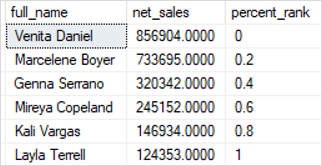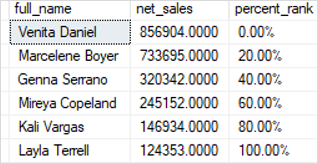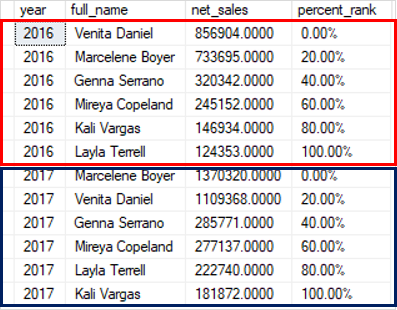Summary: in this tutorial, you will learn how to use the SQL Server PERCENT_RANK() function to calculate the relative rank of a row within a group of rows.
SQL Server PERCENT_RANK() function overview
The PERCENT_RANK() function is similar to the CUME_DIST() function. The PERCENT_RANK() function evaluates the relative standing of a value within a partition of a result set.
The following illustrates the syntax of the SQL Server PERCENT_RANK() function:
PERCENT_RANK() OVER (
[PARTITION BY partition_expression, ... ]
ORDER BY sort_expression [ASC | DESC], ...
)
Code language: SQL (Structured Query Language) (sql)In this syntax:
PARTITION BY
The PARTITION BY clause distributes the rows into multiple partitions to which the PERCENT_RANK() function is applied. The PARTITION BY clause is optional. If you skip it, the function will treat the whole result set as a single partition.
ORDER BY
The ORDER BY clause specifies the logic order of rows in each partition. Because PERCENT_RANK() is order sensitive, the order_by_clause is required.
Return value
The result of PERCENT_RANK() is greater than 0 and less than or equal to 1.
0 < PERCENT_RANK() <= 1
Code language: SQL (Structured Query Language) (sql)The first row has a rank value of zero. Tie values evaluate to the same cumulative distribution value.
The PERCENT_RANK() function includes NULL values by default and treats them as the lowest possible values.
SQL Server PERCENT_RANK() examples
Let’s take some examples of using the PERCENT_RANK() function.
The following statement creates a new view named sales.vw_staff_sales for the demonstration.
CREATE VIEW sales.vw_staff_sales(
staff_id,
year,
net_sales
) AS
SELECT
staff_id,
YEAR(order_date),
ROUND(SUM(quantity*list_price*(1-discount)),0)
FROM
sales.orders o
INNER JOIN sales.order_items i on i.order_id = o.order_id
WHERE
staff_id IS NOT NULL
GROUP BY
staff_id,
YEAR(order_date);
Code language: SQL (Structured Query Language) (sql)Using SQL Server PERCENT_RANK() function over a result set example
This example uses the PERCENT_RANK() function to calculate the sales percentile of each sales staff in 2016:
SELECT
CONCAT_WS(' ',first_name,last_name) full_name,
net_sales,
PERCENT_RANK() OVER (
ORDER BY net_sales DESC
) percent_rank
FROM
sales.vw_staff_sales t
INNER JOIN sales.staffs m on m.staff_id = t.staff_id
WHERE
YEAR = 2016;
Code language: SQL (Structured Query Language) (sql)Here is the output:

To make the output more readable, you can use the FORMAT() function to format the percent rank in percentage (%):
SELECT
CONCAT_WS(' ',first_name,last_name) full_name,
net_sales,
FORMAT(
PERCENT_RANK() OVER (
ORDER BY net_sales DESC
) ,
'P') percent_rank
FROM
sales.vw_staff_sales t
INNER JOIN sales.staffs m on m.staff_id = t.staff_id
WHERE
YEAR = 2016;
Code language: SQL (Structured Query Language) (sql)The following picture shows the new output:

Using SQL Server PERCENT_RANK() function over partitions example
The following example uses the PERCENT_RANK() to calculate the sales percentile for each staff in 2016 and 2017.
SELECT
year,
CONCAT_WS(' ',first_name,last_name) full_name,
net_sales,
FORMAT(
PERCENT_RANK() OVER (
PARTITION BY year
ORDER BY net_sales DESC
) ,
'P') percent_rank
FROM
sales.vw_staff_sales t
INNER JOIN sales.staffs m on m.staff_id = t.staff_id
WHERE
YEAR IN (2016,2017);
Code language: SQL (Structured Query Language) (sql)Here is the output:

In this example:
- The
PARTITION BYclause distributed the rows by year into two partitions, one for 2016 and the other for 2017. - The
ORDER BYclause sorted rows in each partition by net sales from high to low. - The
PERCENT_RANK()function is applied to each partition separately and recomputed the rank when crossing the partition’s boundary.
In this tutorial, you have learned how to use the SQL Server PERCENT_RANK() function to calculate the relative rank of a row within a group of rows.